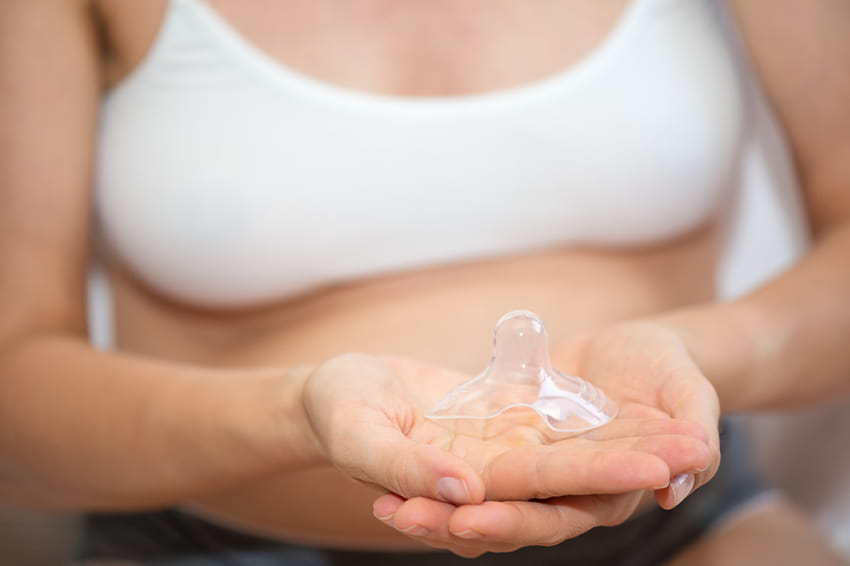How to manage nipple soreness and breastfeeding pain

As a baby emerges from a warm, watery womb into the world, the pains of labor are all part of the natural process. As a new baby starts to suckle at the breast to feed, there will be some initial tenderness and nipple soreness as you adjust to this relationship together. The benefits of bonding, skin-to-skin contact, and nourishment are the driving force for many new moms as they push through the first few days of discomfort.
A smaller portion of mothers will experience latch pain. There are several reasons why new moms experience nipple soreness and pain when breastfeeding.
About a quarter of women experience pain as a result of the shape and size of their nipples, which can make it challenging for the baby to latch and feed. The positioning of the baby's tongue can make breastfeeding painful, as can sore and cracked nipples, plugged ducts, and an infection in the breasts called mastitis. In many cases, it just takes time to get used to the feelings and sensations of breastfeeding as your milk supply switches from teaspoons to ounces.
Dr. Marie Luksch, an OB/GYN with Main Line Health, says nearly all women experience some degree of breastfeeding discomfort or tenderness at some point. "You can get different kinds of pain at different points in your breastfeeding journey," says Luksch, who also has experience from breastfeeding three of her own babies.
Most of the time, the pain or discomfort is not a cause for concern and can be easily treated and managed. In other cases, however, persistent nipple soreness and pain from breastfeeding may be a sign that something more serious is going on that requires more intensive treatment.
Here's what causes breastfeeding pain and what new moms can do to address it.

How the shape of your nipples affects breastfeeding nipple soreness
The number one cause of nipple pain during breastfeeding can be traced back to the size and shape of the mom's nipples. Donna Sinnott, sometimes fondly referred to as "Boob Donna," a Main Line Health lactation consultant who teaches various breastfeeding courses, urges all women to take a prenatal breastfeeding class as prenatal preparation is key. One in four moms have flat or inverted nipples that can cause nipple soreness and breastfeeding pain, says Sinnott, because in this situation the baby has to open wide and use a stronger suck to take in milk.
Sinnott recommends doing "the pinch test" to understand how the shape of your nipples might impact breastfeeding. "Pinch and try to see if your nipple pops out and changes shape when it's exposed to stimulation or heat or cold," Sinnott says. Awareness is key.
Women with flat or inverted nipples can use breast shells, which are worn in between feedings and help contour the shape of the breasts into a nipple-type shape. There are also nipple shields that can be worn during feedings and nipple everters, which can draw the nipples out for feeding.
Breast milk supply after delivery
During the first few days after delivery, milk supply is in smaller, more concentrated quantities. "In the first 72 hours, the babies are working really hard to get that first milk out," says Sinnott. The initial milk, called colostrum, is filled with antibodies and immune boosters and has a thick, syrupy consistency. Most women will experience tenderness or nipple soreness while breastfeeding immediately following childbirth.
Between 72 and 96 hours after delivery, milk production ramps up and the milk becomes white and thinner. During this time, the type of suck changes and breastfeeding typically becomes more comfortable. Milk supply varies greatly from person to person — some women will gradually experience an increase in milk production and others will quickly notice a rush of milk.
Ninety percent of moms will go on to produce a full milk supply within two weeks, but about 10 percent won't. Women who have difficulty producing milk can use donor milk or safely prepared infant formula. Our breastfeeding tips and breastfeeding FAQs might help answer additional questions you have.
Nipple soreness and cracked nipples from breastfeeding
In some cases, the baby's latch or positioning can cause nipple soreness or cracked nipples while breastfeeding. Most soreness will resolve a few minutes after the baby begins breastfeeding. A proper wide latch will help reduce most of the pain or discomfort caused by breastfeeding. In the hospital setting and at home, a lactation consultant can help your baby latch to your breast properly and get into a regular feeding pattern. They can also help figure out if there's another issue that may be causing the soreness or tenderness.
A lanolin-based cream, which essentially acts as "Chapstick" for your nipples, can alleviate soreness. Some women don't like the sticky feeling of lanolin and may prefer to opt for an oil-based lubricant like olive oil or coconut oil.

Breastfeeding nipple soreness caused by baby's tongue and jaw
About 10 to 15 percent of babies have a tight or short frenulum — the thin band of tissue under the tongue — which can impact the baby's latch to the nipple and can cause breastfeeding pain. Babies with a tongue restriction can't lift or extend the tongue well and it can feel as though your baby is chewing on your nipple.
Your health care provider can do a quick procedure in which the tongue is clipped. "The sooner it gets set free, the better it is for the muscle memory of the baby and the comfort of the breastfeeding mom," Sinnott says.
Breastfeeding pain caused by mastitis and plugged ducts
Mastitis is a painful condition that takes hold in the breast tissue. It occurs in about 10 percent of breastfeeding moms. Just like any other infection, the tissues get inflamed and some moms can get a
fever or flu-like symptoms. Mastitis can also be caused by plugged ducts. Excess milk can get stuck, or plugged, in the ducts within the breasts. If the milk gets stuck, the breasts can become sore and lumpy.
Sinnott recommends treating the infection as you would a sore throat: rest, drink fluids, and take medically approved pain relievers like ibuprofen or acetaminophen, if necessary. Antibiotics can be prescribed to help clear the infection. Women with mastitis or clogged ducts will want to continue breastfeeding as this will help keep the milk flowing. Warm compresses, soaks, and massages can help ease pain or tenderness that comes with clogged ducts.
What to do if breastfeeding pain persists
For some women, breastfeeding has many benefits and is very rewarding. For others, it will be challenging and overwhelming. While it's a rewarding thing to try, Luksch says, "Breastfeeding is not for everybody. For some people, it doesn't work out and that's fine."
If you are struggling with breastfeeding and nipple soreness, ask for help first. Talk to a lactation consultant, your pediatrician, or your OB/GYN. "Everybody has challenges, even people who teach people how to breastfeed," Luksch advises. Many women find relief by removing their bras and giving their breasts some breathing room in between feedings, says Sinnott. The creams can alleviate the soreness, and some women with lingering pain may require a prescription ointment.
If you continue to feel pain while breastfeeding and it's impacting your mental health or relationship with your baby, you have many options for feeding your baby. Your doctor or a lactation consultant can help you map out a feeding plan that's right for you and your baby.
Main Line Health serves patients at hospitals and health centers throughout the western suburbs of Philadelphia. We offer informative prenatal breastfeeding classes to learn techniques to get you off to a good start. To schedule an appointment with a specialist at Main Line Health, call 1.866.CALL.MLH (225.5654).
 Content you want, delivered to your inbox
Content you want, delivered to your inbox
Want to get the latest health and wellness articles delivered right to your inbox?
Subscribe to the Well Ahead Newsletter.
